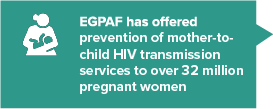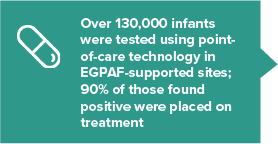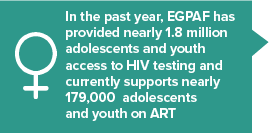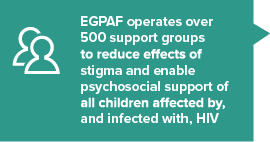FACTS ABOUT: Pediatric Care and Treatment Access
Each day, about 500 children are newly infected with HIV and many more require HIV prevention, care, and treatment services. Reaching these children and their mothers is at the core of our mission at the Elizabeth Glaser Pediatric AIDS Foundation (EGPAF). EGPAF was established over 30 years ago by a mother dedicated to ensuring that her children, and HIV-positive children everywhere, receive the care and treatment needed to live long and healthy lives.
We have made progress toward our mission to eliminate pediatric HIV by advocating for policies that support innovations in pediatric HIV diagnostics and medications. We have moved closer to a generation free of HIV as a result of our active support of underfunded areas of pediatric HIV research. As a program implementer, we have given prevention and treatment access to thousands. The fact is, however, there are still 1.8 children living with HIV and a growing number of children and adolescents infected each day. EGPAF is working to address the epidemic in this population through the following approaches.
Prevention of HIV transmission from mother to infant

Over 90% of infants diagnosed with HIV became infected from their HIV-positive mothers during pregnancy, delivery, or breastfeeding. Antiretroviral treatment (ART) given to HIV-positive pregnant and breastfeeding women, in combination with infant prophylaxis, can reduce this transmission risk to below 5%. EGPAF works to ensure that every woman accessing prenatal services has the resources to protect her health and her infant from transmission of HIV prior to and after the birth of her child. We also ensure that every mother and child receiving obstetric and postnatal care are tested for HIV and linked to lifelong treatment. Our postnatal care includes infant feeding guidance both within and outside the context of HIV.
Enhancing HIV testing among infants and young children

Undiagnosed and untreated HIV-infected children face a 50% mortality risk by their second birthdays. Testing and treating children early has long been a priority in our work. With peak mortality of untreated infants occurring at just eight to ten weeks of life, there is a critical need for urgent identification of HIV and faster delivery of treatment. EGPAF has procured and placed point-of-care early infant diagnostic technology in high-volume sites in nine countries. We have expanded HIV testing opportunities also by integrating diagnostics within routine child wellness care, such as growth monitoring, nutrition, TB, and vaccine service delivery points. Further, these machines are now also handling viral load testing among HIV-positive pregnant and breastfeeding women.
Treating infants and young children living with HIV

Despite being the most vulnerable to HIV-related deaths, young children often endure the toughest path to treatment. In 2019, only 53% of the 1.8 million HIV-positive children in the world had access to ART. Children with HIV encounter multiple challenges such as poor availability of pediatric antiretroviral formulations, pediatric ART drug stock-outs, and limited training of a health care workforce in the management of pediatric diseases or childhood behaviors. Throughout our supported health facilities, EGPAF promotes expanded access to pediatric HIV treatment and counseling. We also support national policies that implement globally-recommended pediatric HIV treatment guidelines.
Enhancing HIV identification and access to treatment from childhood through adolescence

For children who grow up in high HIV burden areas, exposure to infection increases in adolescence and early adulthood. About 6,000 adolescents and youth are infected with HIV every week. EGPAF supports activities in 17 counties to ensure children and adolescents are mobilized, empowered, HIV tested, and linked to care. We work with communities, schools, and media platforms to increase HIV education opportunities. We ensure greater availability of HIV testing and treatment among adolescents through school-based education and testing, community engagement, mobile testing campaigns, and implementation of differentiated testing and treatment service models. At the national level, we advocate for policies, which reduce parental consent ages to encourage greater access to HIV testing among children and adolescents. We have also launched the Community of African Youth Advisors global initiative, which allows young people to inform HIV and AIDS programs. This initiative has, to date, led to changes in minimizing discriminatory practices in clinic settings and enhanced HIV disclosure processes.
HIV care and treatment support in childhood and adolescence

Disclosure of HIV infection to a child can trigger an emotional response. Discrimination faced by children and adolescents living with HIV, or poor supportive family or social environments, can result in treatment interruptions, which lead to increased risk of drug resistance, compromising future treatment options. To ensure all children and adolescents are supported through lifelong treatment, we train facility staff to respond to the needs of children and adolescents and work with communities to reduce HIV stigma and discrimination. We support adherence counseling for caregivers and parents and also offer a range of psychosocial support services for children, adolescents, and caregivers to help cope with HIV diagnosis, treatment, and transition from pediatric to adult care settings.
Treatment monitoring from childhood through adulthood

Throughout the continuum of pediatric HIV care, we promote active treatment monitoring to ensure that children in our supported services have access to viral load testing and reach full viral suppression (meaning that HIV is present at a very low levels in the blood). Viral suppression, crucial for a long and healthy life, also reduces the risk of HIV transmission to an HIV-negative individual in adulthood by as much as 96%. For those who are failing treatment, EGPAF trains and supports health workers in early identification of treatment failure, provision of necessary drugs and guidance to switch to more effective regimens, if needed.
Global
